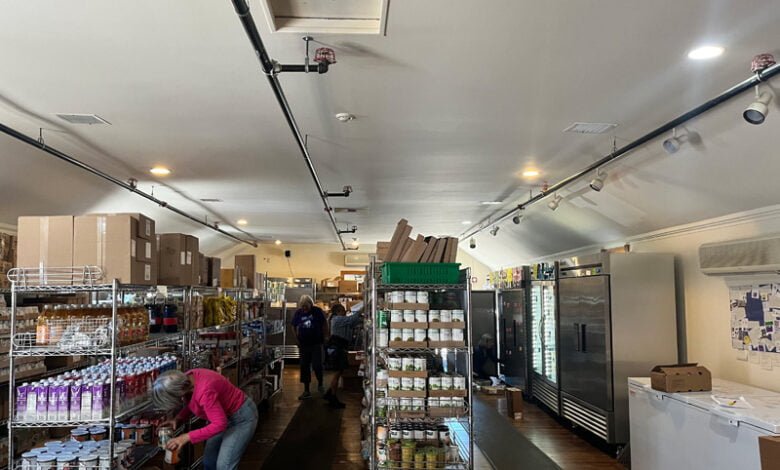Thousands of Islanders use free food programs

Every weekday afternoon, Jenny Devivo stocks the Martha’s Vineyard Boys and Girls Club two-year-old free food pantry with fresh produce, meats, and ready-made meals for needy families.
As a line forms out the door, she hands out farm donations, rescued food, discounted Costco and Ocean State Job Lot products, and 200 meals a day to students in an afterschool program and their families.
“The majority of our year-round residents are struggling not only to find a house but also to put food on their table,” said Devivo, who also runs a larger pantry at the Edgartown-based club twice a week.
Martha’s Vineyard is often known off-Island as an affluent summer colony, a playground for the rich and famous who live in ever-larger houses on vast beachfront properties. But few year-round residents and workers live in that gilded reality.
“It’s hard to spend $600 a week at Stop & Shop,” said one of the club’s 350 members, who is trying to feed a single-income household. She asked to remain anonymous because she’d rather not have her name in the paper. The free food “tremendously helps,” she said.
“There’s always been a lot of low-income people on the Vineyard that struggle in the wintertime, but there’s more people on the Vineyard now, and I think that’s why the need has gone up,” she added.
Indeed, one in four year-round Islanders — or 5,200 out of 20,530 — now are registered with the Island Grown Initiative (IGI) free food pantry, the largest on the Island.
Not everyone registered uses the IGI pantry regularly, but the number of those who did jumped fourfold in five years — from 678 individuals in January 2019 to 2,753 this past January. The numbers continue to grow, and in May, 106 new people registered with the pantry.
Seniors and children make up one-third of those served. Many of the others are working adults or day laborers struggling to make ends meet.
Through their prepared food program, IGI handed out 2,304 frozen meals in 2018. That shot up to 40,797 — a 1,670 percent increase — in 2022. To address the growing demand, the team plans to make and distribute 60,000 meals this year.
“Is our hope that those numbers decrease? Absolutely,” Gail Arnold, board chair for IGI, said. “We don’t want people to have to use the pantry. We would love to be out of business in that way. I don’t think anybody in the food-equity world would say they think they’ll be out of business anytime soon.”
Island experts say there’s no one explanation for the increase. But given inflation, and the high price of food, as well as other economic pressures since the start of the pandemic, a growing number of families struggle to get through the week without this extra food from one of the half-dozen or so food banks on the Island.
“If you have food insecurity, you can go to five or six different places, and you would not be turned away, which is quite frankly fabulous, but unfortunate when you think about our paradise Island, that that’s the way it is,” Arnold said.
Based at the Portuguese-American Club in Oak Bluffs, the IGI food pantry is open 2 pm to 4 pm Mondays, 1 pm to 6 pm Wednesdays, 10 am to noon Saturdays, and from noon to 2 pm on Fridays for seniors. Fourteen drivers deliver food and dry goods to shut-ins on Thursdays.
Food equity director for IGI Merrick Carreiro and about half a dozen volunteers unpack roughly 7,000 pounds of food from the Greater Boston Food Bank, which they get for free or at a reduced cost, each Tuesday, and the first Monday of every month.
She also stocks fridges and shelves with fruit and vegetables gleaned from IGI’s 40-acre farm, chicken and eggs donated by Slough Farm, and loaves of bread from Grey Barn and Iggy’s Bread.
To keep up with increased demand, the food pantry will move to a new facility on 114 Dukes County Ave. in the early part of August. The new pantry has larger fridges and freezers, more storage space to backstock food should a ferry get canceled, and a drive-through system to make pickups easier. Seniors will still be able to shop in person.
Though the new project has been largely sponsored by the Martha’s Vineyard Bank, the CARES Act, a federal stimulus bill intended to counter economic fallout from the pandemic, ends this month for IGI. They received just under $2 million over the past three years, and now hope to increase fundraising efforts to replace that funding.
“The Island needs to sustain the people that come to the food pantry, because they work at the services that run this place,” Carreiro said.
To be sure, the increased demand on-Island mirrors growing challenges across the state. The Greater Boston Food Bank (GBFB), recently reported that nearly one in three, or 1.9 million, Massachusetts adults faced food shortages at the end of 2023, an increase of 100,000 from the year before. The food bank cited “exorbitant costs of living, increased grocery prices, and end of pandemic-era supports” for the figures.
Other programs on the Island have also seen a dramatic increase in demand.
Serving Hands, a program run under the Vineyard Committee on Hunger, delivers food to 80 people on the Island, and in the summer, as the Island gets busier, that number will increase by 20 to 40 people, Alicia Nicholson, president of the committee, said.
“The number has gone up since the pandemic, especially in winter months,” she said. “There’s a lot more need.”
In January and February this year, Food Baskets MV, also known as Good Shepherd Parish Food Pantry, saw 200 people a day walk through their door.
“Those 200 people represent a family of up to six people,” Sarah Steigelman, outreach distributor for the program, said.
A few years ago, they saw a maximum of 70 to 75 clients every Tuesday and alternate Saturdays, when the pantry is open.
Grace Church in Vineyard Haven began its community supper program, which runs every Friday from November to the end of March, at least 30 years ago, Heather Raveling, parish administrator, said.
The program uses church funds to make hot meals from Stop & Shop, Cash and Carry, and other food sources. It also receives donations.
Two winters ago, it provided meals to 60 to 80 people, Raveling said. Last year, that number was closer to 85 to 95 people, and this past winter, it peaked at 150 people.
To help meet the demand, the church plans to start a new program this fall. They’ll have a stocked vegan community refrigerator outside the parish house that will be open 24 hours a day.
Marjorie Peirce, outreach coordinator for the community suppers program at the First Congregational West Tisbury Church, has also seen an increase in patrons. Before the pandemic, it organized sit-down dinners in the church for 80 people. But now they serve closer to 150 people, with pickups or drop-offs.
There are too many people to organize a sit-down meal in the parish house, she said. “We get some people of the older population who can’t cook anymore for themselves to people who are unhoused,” Peirce said.
The age group that the Council on Aging’s food pantry serves has expanded from mostly seniors to many seasonal workers in Edgartown, according to Lyndsay Famariss, the council’s director.
“The depth of need is a lot deeper. It’s not just a box of cereal and rice. They really need soup to nuts,” Famariss said.
They receive a shipment of food from GBFB once a month, and it’s “often wiped out soon after the delivery comes,” she added.
Two years ago, the West Tisbury library began its Community Freedge program (nicknamed to describe the fridge of free food). Just inside the front door, a refrigerator and shelves are stocked with donated produce, canned goods, dairy products, personal care items, and cleaning supplies. They are available to everyone.
Donations from individuals, food rescued from Cronig’s Market, produce from Slough Farm, and prepared frozen meals from IGI keep the fridge full every week. Alexandra Pratt, director of the library, said the program feeds more than 250 people a week.
“It’s a real community effort,” Pratt said. “It takes a village to feed a village.”
More people utilize the library’s fridge every year, but Pratt said that may be a result of increased awareness and exposure of the resource, as well as the fact that as “housing gets more and more expensive, we’re seeing more and more people struggling to feed themselves and their families.”
From a “hangry” child at storytime who needs a pick-me-up snack to someone who lives in their car, Pratt often hears that the Freedge is a lifeline, she said.
In January, Pratt told legislators and library stakeholders on Cape Cod at the annual CLAMS Legislative Library Day about “a woman who lost her housing she had had for years when it was sold and turned into a weekly rental, and [she] was camping in the State Forest.”
“She came to us in tears, saying without the food available through the library, she wasn’t sure how she would’ve kept herself fed,” Pratt added.
Source link




